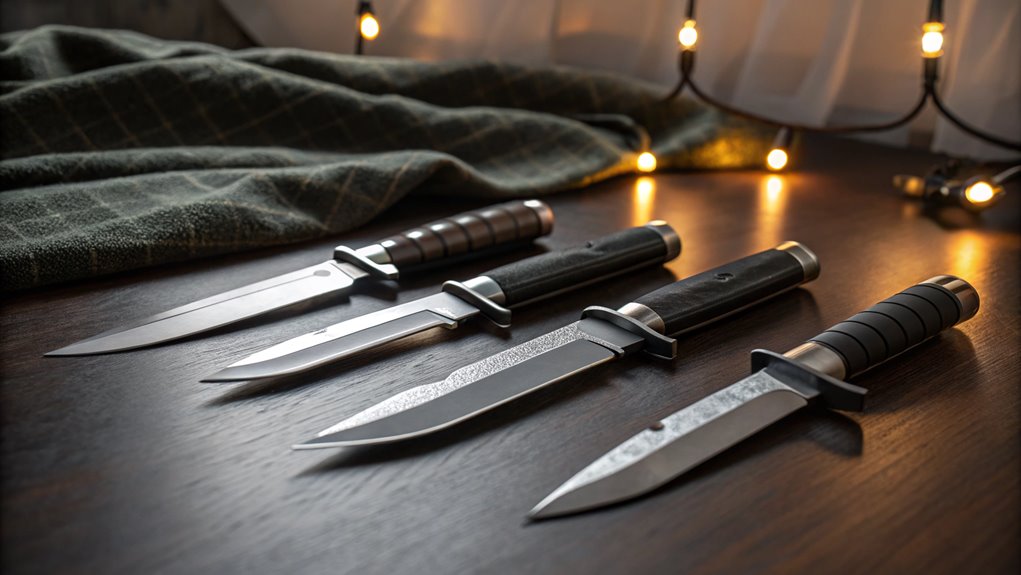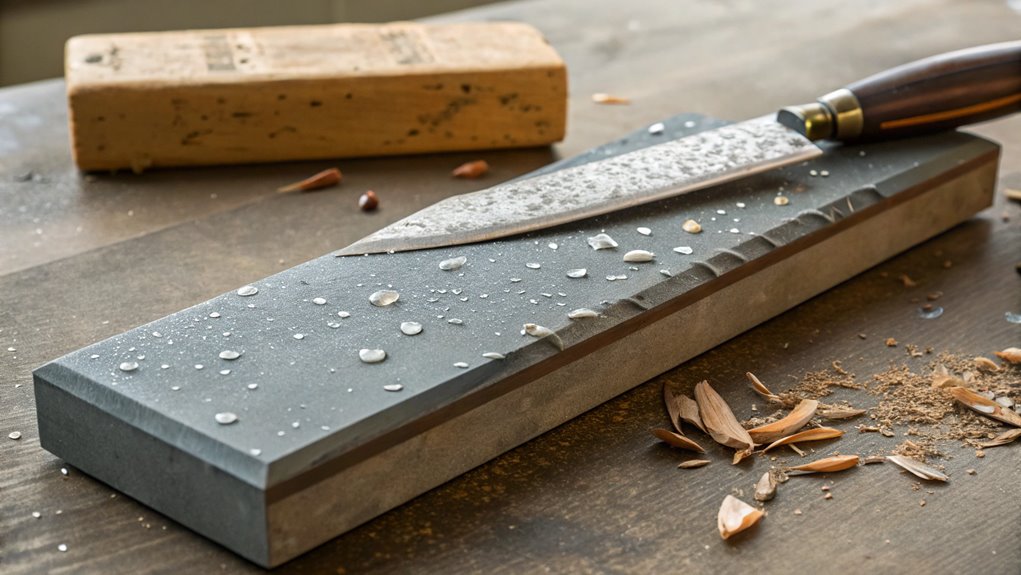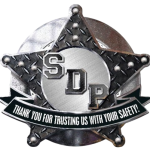When it comes to how to choose the best self defense blades, you want something that’s lightweight, easy to carry, and quick to access because you never know when trouble might strike. Look for corrosion-resistant materials for lasting sharpness, and consider ergonomic grips to guarantee comfort during use. It’s also super important to understand the legal rules in your area around carrying these blades. Getting a versatile tool, like an automatic heavy duty knife, is a smart choice for protection. Trust me, having the right blade can really make a difference when it counts, and there’s so much more to explore on this topic.
Enhanced Personal Safety

When it comes to personal safety, having the right self-defense blade can make all the difference in a tough situation. You want something that’s easy to grab quickly, lightweight enough to carry around, and tough enough to handle the wear and tear of everyday life. Plus, if it’s made from materials that resist corrosion, you won’t have to worry about it failing you when you need it most. The Automatic Heavy Duty Knife with a 5 hole handle is a great option, offering a stainless steel design and a safety lock feature. For those who prefer a multi-functional tool, options like a stun baton, flashlight, heavy-duty club can provide versatile protection in various scenarios.
Quick Access in Emergencies
In critical situations, having a self-defense blade that’s easily accessible can make all the difference in ensuring your safety.
Picture yourself in an emergency scenario where every second counts. If your blade isn’t within reach, it won’t do you any good. You need to make sure that your self-defense tool is right at your fingertips when you need it most.
Here are three key factors to evaluate for effective blade accessibility:
- Location: Keep your self-defense blade in a place where you can grab it quickly, like a pocket, waistband, or a special sheath designed for easy access.
- Training: Practice how to retrieve your blade swiftly, so it becomes second nature during high-stress situations. You don’t want to fumble when it matters most.
- Visibility: Choose a blade that’s easy to spot, even in low-light conditions. A well-designed self-defense blade can help you react faster.
Compact and Lightweight Design
A compact and lightweight design in self-defense blades considerably enhances your personal safety by ensuring you can carry it comfortably without hindrance.
When you have a blade that’s easy to handle and tote around, you boost your confidence and readiness in any situation. You don’t want a bulky weapon weighing you down or making you think twice about carrying it.
Here are three key benefits of choosing the right blade types with portability in mind:
- Quick Access: A lightweight blade means you can draw it faster in emergencies, giving you a vital edge when every second counts.
- Discreet Carry Options: Compact designs can easily fit in your pocket or on your keychain, allowing you to keep it close without drawing attention.
- Ease of Use: Lightweight blades are simpler to wield, especially for those who may lack experience with heavier self-defense tools.
Ultimately, selecting a self-defense blade that’s both compact and lightweight can make a significant difference in how prepared you feel in potentially dangerous situations.
Your safety matters, and having the right tools at your disposal can empower you to face challenges head-on.
Durable, Corrosion-Resistant Materials
Choosing self-defense blades made from durable, corrosion-resistant materials is essential for ensuring your safety. When you’re in a situation where you need to defend yourself, the last thing you want is a blade that can’t hold up. You need something reliable, and that starts with the right blade materials.
Here are three reasons why corrosion resistance matters:
- Longevity: A blade that resists rust and wear will last longer, giving you confidence in its performance when it matters most.
- Functionality: You want a blade that operates smoothly, even in harsh conditions. Corrosion-resistant materials maintain their sharp edges and functionality.
- Peace of Mind: Knowing your self-defense tool is made from tough materials lets you focus on your safety, not on whether your blade will fail you.
Legal Carry Requirements
Understanding the legal carry requirements for self-defense blades is essential for any potential owner. You need to know that there are legal restrictions and state regulations that can affect how, where, and when you can carry your blade. Each state has its own set of rules, and these can vary quite a bit. For example, some states allow you to carry a knife openly, while others might require it to be concealed. Also, be aware of blade length limits; some places restrict blades longer than a certain length, usually around four inches. In addition to blades, steel batons are now legally permissible for self-defense in California, providing more options for self-defense enthusiasts. If you’re traveling, things can get even trickier, as different states may have varying laws. It’s your responsibility to stay informed, so check local laws before making any decisions.
Sharpening and Maintenance Techniques

Keeping your self-defense blade sharp and well-maintained is essential for its effectiveness and longevity. A dull blade won’t just let you down when you need it the most; it can also pose a safety risk.
Start with some basic sharpening techniques, like using a whetstone. Hold the blade at a consistent angle, usually around 20 degrees, and slide it across the stone in smooth, even strokes. Don’t rush it—take your time to guarantee you get a sharp edge.
Next, let’s talk maintenance tips. Clean your blade regularly to prevent rust and corrosion. Wipe it down with a damp cloth after each use, and dry it thoroughly. Consider applying a light coat of oil to protect the metal.
Also, store your blade properly—preferably in a sheath or on a magnetic strip, so it doesn’t get damaged. Check for any signs of wear or cracks, and replace your blade if needed.
Ergonomic Grip Comfort
When it comes to self-defense blades, the grip you choose can greatly impact your control and comfort during use. You mightn’t think about it, but the right ergonomic grip can make a huge difference in how effectively you handle your blade.
Look for grip materials that provide a solid hold, like rubber or textured polymer, which can keep the knife secure in your hand, even when things get intense.
Proper hand positioning is also essential. You want to make sure your fingers fit snugly around the handle, allowing for quick movements without slipping. A well-designed grip can help reduce fatigue during prolonged use, so your hand won’t cramp up when it really counts.
If the grip feels awkward, it could hinder your reaction time, and that’s the last thing you want in a self-defense situation.
Always test a blade’s grip before committing to it. You should feel confident and in control, ready to defend yourself if necessary.
Answers to Common Questions
What Are the Best Materials for Self-Defense Blades?
When considering blade composition for self-defense, you’ll want materials like stainless steel for its durability, or high-carbon steel for sharper edges. These options guarantee your blade withstands stress and stays effective in critical situations.
How Do I Choose the Right Blade Length?
Choosing the right blade length involves considering your personal comfort and how you’ll use it. Think about your hand size, grip, and intended use; a blade should feel balanced and manageable in your hands for effective control.
Are Fixed Blades Better Than Folding Knives for Self-Defense?
When considering fixed blades versus folding knives, you’ll find fixed blades offer advantages like strength and reliability. However, folding knives excel in portability, making them easier to carry daily while still providing decent self-defense options.
Can Self-Defense Blades Be Used for Everyday Tasks?
Did you know nearly 70% of knife owners use their blades for everyday tasks? Self-defense blades often have practical uses, making them dual-purpose tools. You can rely on them for both protection and daily activities effectively.
What Is the Best Way to Carry a Self-Defense Blade?
To carry a self-defense blade effectively, you should consider blade concealment techniques, like using a discreet sheath. Always check legal considerations in your area to guarantee you’re compliant with local laws regarding blade carry.
Bottom Line
So, think of your self-defense blade as a trusty shield in a world full of dragons. It’s not just about having one; it’s about knowing how to wield it wisely and keeping it sharp, just like a knight prepares for battle. You’ve got to check the laws in your kingdom to guarantee you’re carrying it legally, and remember to choose one that feels comfy in your hand. Stay safe, stay smart, and always be ready to defend your castle!




